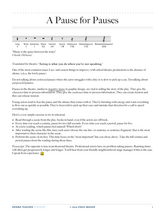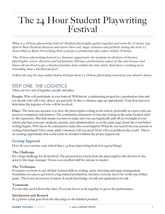Playwriting
A Pause for Pauses
Pauses serve a great purpose in theatre. What's not being said in that pause? Here's an acting exercise to use in rehearsal.
Read More...
Read Less...
Automatic Writing Prompts
Use these prompts as bell-work or as warm ups before a writing exercise. The focus of automatic writing is to get words on the page: good, bad and ugly.
Read More...
Read Less...
Distance Learning: Issue Personification
Students will be able to demonstrate how to visualize an issue through character.
Read More...
Read Less...
Attachments
Headline Characters Exercise
Use this exercise to practice creating characters and then writing the first few lines of a monologue. Students will use a headline as a jumping off point.
Read More...
Read Less...
How to Give Feedback to Student Playwrights
Author Nick Pappas has created a resource for teachers to develop the tools they need to help student writers find their voice. This resource focuses on two big questions: What is Feedback?, and What is Useful Feedback?
At its core, all answers will focus on giving notes that will improve the work, which, in this case, is our students’ plays. And, as a teacher, that’s the goal: we want our students to
write and to grow through their writing. If we want students to get better, we need to get better. Understanding the definition of feedback and understanding how to provide useful feedback is the key to all of us getting better.
Read More...
Read Less...
Picture Prompts
Picture prompts are a great way to initiate student writing. They don’t have to have an idea, they simply respond to the picture. Have students study the picture and answer the provided questions. Each picture includes a character or a story element question.
Read More...
Read Less...
Playreading Project: Diversifying the Bookshelves
The goal in this ongoing work to be a loving, inclusive teacher in a loving, inclusive space is to continue to build the library in your room to represent every student. Providing access to these materials within the walls of a classroom allows students to engage in the literature without judgment.
This document offers a teacher self-assignment task to populate your bookcase with inclusive, diverse material and then a couple of classroom tasks you can do to make sure your books get noticed.
Read More...
Read Less...
Attachments
Playwriting Outside the Lines Poster Series
A set of 5 posters to inspire in the drama classroom. Part of the Playwriting Outside the Lines PD course in the DTA.
Read More...
Read Less...
Attachments
Playwriting: Developing A Point of View
One of the best things a playwright can do is develop a point of view. This is a self reflection exercise and scene writing exercise all rolled into one.
Read More...
Read Less...
Posters: Devising for the Drama Classroom (set of 4)
A set of four posters for your drama classroom - each with a different message about devising.
Read More...
Read Less...
Self Reflection Sentence Starters
Sometimes all students need is a little push. Give students one of these self reflection sentence starters to get them going. You'll be amazed at what they write next.
Read More...
Read Less...
The 10 Line Scene
Practice the act of writing a two character, one location scene with these short exercises. Whatever the scenario, limit the length: 10 lines per character.
Read More...
Read Less...
The 24 Hour Student Playwriting Festival
What is a 24 hour playwriting festival? Student playwrights gather together and write for 12 hours. (eg: 8pm to 8am) Student directors and actors then cast, stage, rehearse and perform during the next 12 hours (8am to 8pm). Everything from concept to production takes place within 24 hours. Follow the step by step outline in the resource.
Read More...
Read Less...
The Creative Sandbox: Your Journal
This journal was created as an accompaniment to Steven Stack's DTA course: Playwriting Outside the Lines. It can also be used as a stand alone resource, as a writing tool and a path for creation. The journal is divided into 5 sections: Creative Sandbox, Play/Scene Development, Random Thoughts and Lines, Home of the Rough Drafts, and Notes from Others.
Read More...
Read Less...
© Copyright 2015-2024 Theatrefolk

